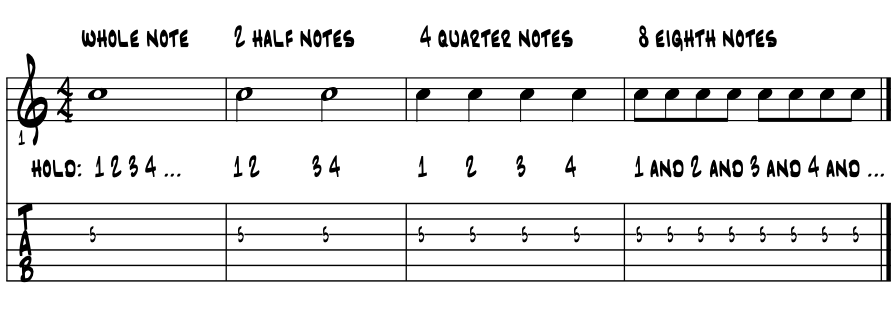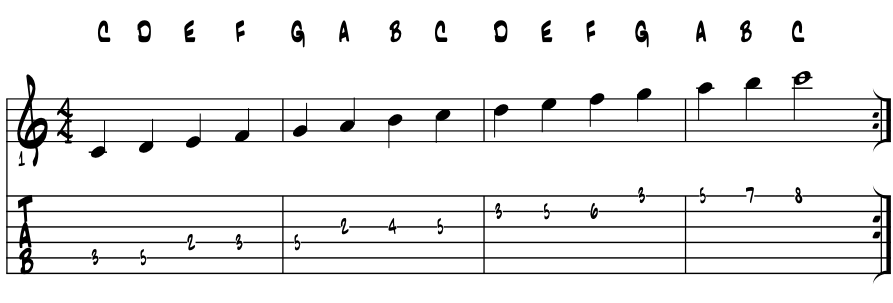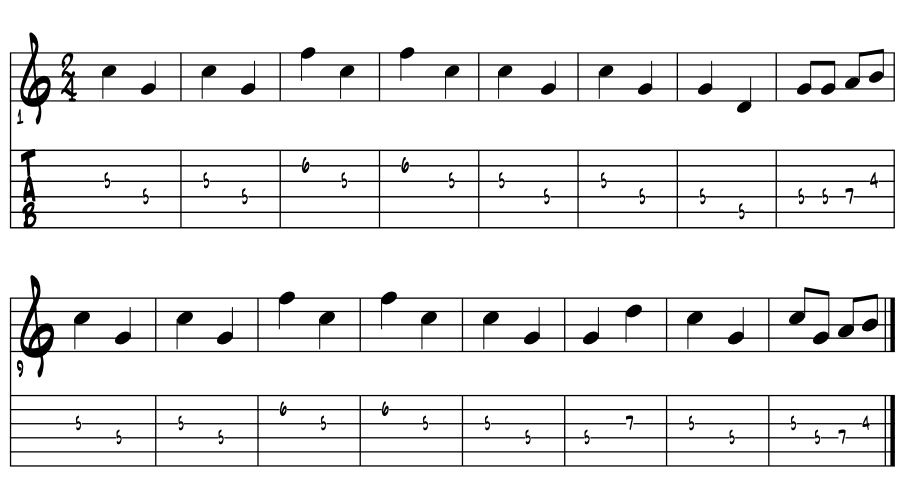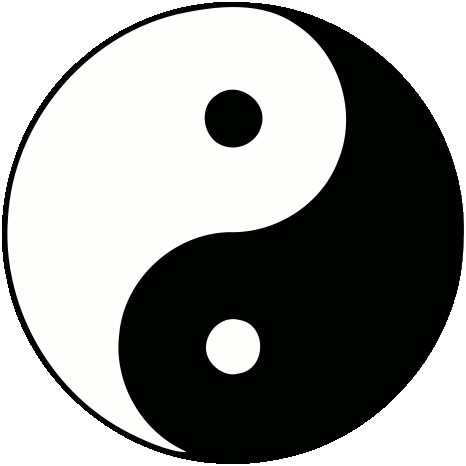~ understand written rhythms ~ ' ... we can record songs with written symbols ...' |
In a nutshell. That we can record a song by writing symbols is a very trippy thought these days, as recording music audio with a device is now quite common. The goal here is to gain enough skill with the old fashioned symbols so as to be able to decipher a song's rhythm pattern, to clap our hands to its rhythm patterns, as written out by the symbols. Conquering this basic skill sets in motion a lifetime of learning new music, through reading standard musical notation. For once we got the rhythms going, the melody pitches turn out to be the easy part, who knew ! :) Skills we gain. Along the way we gain the ability to feel and find the downbeat of each measure, the heartbeat pulse of a song's groove and 'feel.' Learn to count the measures or bars as a song's story moves along 'in time' to the music. Then, to count how many measures are in a song's melody phrase, finding the 'top' of the song's story form, and then its full length structure. |
Please know also that these music notation symbols have been used in European musics for a 1000 years now, so most of the bugs have been worked out of this notation system, so can be pretty accurate for a composer's intent. That said, we Americano's often capture our own mojo by 'feel.' Especially so in the blues, as the power of the blue note phrasing is traditionally learned aurally, by ear and tricky to notate. And since the blues is often the 'roots' of Americana styles, 'by ear' just encourages us to phrase melodies our own unique way. Sing the line, play the line. Folks do it all the time of course, both read and write the blues with standard notation symbols, then we can respectfully interpret and bring a song back to life via the black dots. |
"Blues is the roots, everything else is the fruits." |
wiki ~ Howlin' Wolf |
Clapping rhythms. For those learning here who are challenged reading notation, gaining skill in clapping the rhythms can be a game changer in learning new songs from written music. Becoming a better reader is just about 'doing it.' And in the meantime, if we have songs we want to learn, and have sheet music, we can 'split' the pitches from the rhythms and learn each separately, the glue them back together. Either way will work, but getting rhythms first gets us grooving in the song. Then adding pitches can become the easy part. Clap the rhythms, add the notes, sing the line and good to go ! |
How do we measure the rhythm of a note ? So how long is a note held in time ? That's what we're measuring here. The easiest math of all of this is with the 'big 4', the 4 / 4 time march time / the indigenous heartbeat, the basis of the swing, the walk along 'andante' for cooking pasta. Then all we do is divide up the four beats a couple of different ways. So, 4 /4 is ...
top 4 = number of beats per measure bottom 4 = what note value gets one beat |
|
So, how do we measure the rhythm of a note ? Simply by the number of beats it gets. Thinking 4 / 4 ... Whole note gets all four beats of one measure. Half note gets two beats, so two per measure. Quarter gets one beat. So four per measure. Eighth notes get a half of a beat, so two 1/8th's per beat. Here's the above in symbols. Clap along and rote learn 1000 year old symbol time magic. Example 1. |
 |
Try this one. Clap along and rote learn 1000 year old symbol time, the magic black dots. Example 2. |
|
 |
Cool ? Not really too rocket science is it ? |
Subdivision of the beat. The whole tamale really in 4/4 time, clap along as best U can :) Example 3. |
 |
Got the sense of how this rolls ? Simply 'half again' math, each time we subdivide a beat. |
'In four.' 'Four four' time is our most common groove through the Americana songbook. Four beats per measure and the quarter note gets the beat. The 'big 4' walking bass lines, even the 'club' 'boom boom boom boom', are four beats per measure. This next idea is probably more of a bass line than melody, just straight quarter notes motoring along. Count it in measures as; '1 2 3 4, 2 2 3 4, 3 2 3 4, 4 2 3 4 ... ' Example 4. |
 |
Quarter note gets the beat. And the beat goes on :) |
'In three ~ waltz time.' In 'three' or 3/4, gives us three beats per measure. From the Euro view we call this a waltz, a dance style that goes way back in European history. Count 3/4 in measures as; '1 2 3 , 2 2 3 , 3 2 3 , 4 2 3 ...' Here we head for the ball park for a true Americana melody 'in 3.' Note octave leap to open the line. Example 5. |
 |
Know this song? Cool. No, just learn it here if need be. This melody in particular, 'in three', puts a 'back and forth' sort of 'lilting' motion into the groove. And with 'three of anything' we can make a triplet, that figure of notes we spice back into 4/4 time to set some swing into motion. |
Learn one ... :) Oftentimes in learning art and one's creative, doing a 'something' one time can create a paradigm shift in the knowledge base of the learner. It's one of those 'a light goes on moment.' This 'learn one' also applies to songs. Where learning one song 'stem to stern', can be a game elevator. |
A jazz song 'in 3.' Harmonica wizard Toots Thielemans' song "Bluesette" is a standard, that sets a standard, for songs that we call a 'jazz waltz.' In rhythm, feel and time, this description of a 'jazz waltz in three', so three quarter notes per measure, usually means; a walking base line, a cycle of chords by fourths, a sure form with a clear top, and melody and lyrics that reflect this song's title. 'Standard' status comes with quality of workmanship, and how well the art of it reaches into the collective of interested patrons. For every art, and science for that matters, has a collection of 'like minded' that agree that 'such and such' is a standard in their interests. Any tune can go up the top 40, but that doesn't necessarily mean it's a 'standard.' So as time permits the jazz leaning artist, do explore and learn more of this "Bluesette" song. Its a gem among gems, just a perfect melody that sings itself right into receptive ears, which chock full of cool theory that clearly captures an Americana 'jazz waltz in 3.' |
|
'In two.' In today's music, and songs from the last couple of decades, 'in 2' or with a '2 feel', is generally going to be a country style bass line, a One to Five motion, or a Latin styled song, usually with a root, fifth, octave, fifth sort of motion. These basic rhythms and notes can be applied to whatever chord changes come along. And while these two styles generally do not merge on the same stations on the radio dial, they share the same feel, a 'two beat' of 'in 2' groove. Here's the country idea first. Example 6. |
 |
And here's the Latin idea. Example 6a. |
 |
Cool ? Root, 5th, octave, 5th. |
'In one.' Rare beyond rare, there is a tempo in 'one.' From the Euro cats, there's a 'tempo di valse' that finds the conductor's wand moving down for the beat and it's rebound back up for the next drop / beat, controls how fast the band is going. Example 7. |
|
 |
And that is a terrible example, sorry. Now back to something that grooves a bit more :) |
'6 / 8.' In Six / eight, six beats per measure and the 1/8 note gets the beat. Easy way to double 3/4. Example 8. |
 |
'12 / 8.' This time signature is a double up of the last, and is often termed a 'shuffle' in blues circles. Twelve beats per measure, the 1/8 note gets the beat. Simply a series of triplets, which are most often played by the drummer on a ride cymbal. Example 9. |
 |
Cool ? Very common in the blues styles dances. |
'5 / 4.' This five / four time signature is not too common, it's groove is beyond cool for dancers, as it reshapes the motions and steps with its unique way of creating the pulse and downbeat. Five beats per measure, the quarter note gets the beat. Here's the basic pulse from the jazz classic "Take Five." Example 10. |
|
 |
Cool ? The song "Take Five", just might be among the top 10 of Americana jazz songs known the world over. Surely one of a kind, and tricky to get right, one worth learning for the jazz leaning artist as it has the best of both; a brooding sort of modal vamp section and a memorable and lighter diatonic sequential bridge. |
Review. How we write out an idea is often based on how it will be most easily read by those that come after. And learning to read and clap out rhythms is a sure way to internalize a melody's rhythms. Then it's just a matter of getting the pitches right. There's all kinds of grooves and rhythms out there, and nowadays we get a global reach from wherever we are with a computer device, so explore and dance, sing your rhythms and find your own sense of 'how it swings' with melodies that go deep into your own musical history, back to when we're kids. For if we get those lines to swing, the one's we know the best, we're golden. That's a real joy in making music, play from the heart, then sharing it to create community. |
"Once you replace negative thoughts with positive ones, you'll start having positive results." |
wiki ~ Willie Nelson
|
References. References for this page's information comes from school, books and the bandstand and made way easier by the folks along the way. |
Find a mentor / e-book / academia Alaska. Always good to have a mentor when learning about things new to us. And with music and its magics, nice to have a friend or two ask questions and collaborate with. Seek and ye shall find. Local high schools, libraries, friends and family, musicians in your home town ... just ask around, someone will know someone who knows someone about music and can help you with your studies in the musical arts. |
|
Always keep in mind that all along life's journey there will be folks to help us and also folks we can help ... for we are not in this endeavor alone :) The now ancient natural truth is that we each are responsible for our own education. Positive answer this always 'to live by' question; 'who is responsible for your education ... ? |
Intensive tutoring. Luckily for musical artists like us, the learning dip of the 'covid years' can vanish quickly with intensive tutoring. For all disciplines; including all the sciences and the 'hands on' trade schools, that with tutoring, learning blossoms to 'catch us up.' In music ? The 'theory' of making musical art is built with just the 12 unique pitches, so easy to master with mentorship. And in 'practice ?' Luckily old school, the foundation that 'all responsibility for self betterment is ours alone.' Which in music, and same for all the arts, means to do what we really love to do ... to make music :) |
 |
"These books, and your capacity to understand them, are just the same in all places. Always bear in mind that your own resolution to succeed, is more important than any other one thing." |
|
Academia references of Alaska. And when you need university level answers to your questions and musings, and especially if you are considering a career in music and looking to continue your formal studies, begin to e-reach out to the Alaska University Music Campus communities and begin a dialogue with some of Alaska's finest resident maestros ! |

